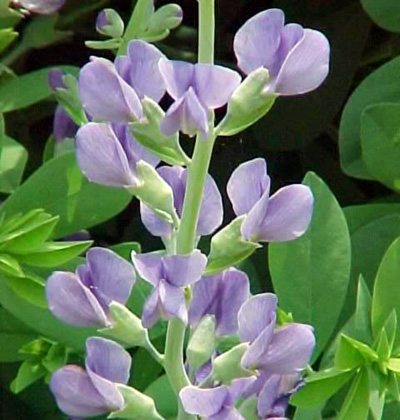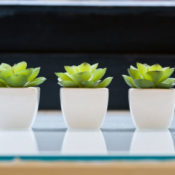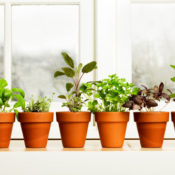If someone asked me to design my idea of the “perfect” perennial, it would come pretty darned close to being this year’s selection for Perennial of the Year. Gorgeous purple-blue flowers, widely adaptable, native, well-behaved, relatively pest-free, and long-lived garden plant all describe Baptisia australis, which was named the Perennial Plant of 2010 by the Perennial Plant Association (PPA).
Native to much of the Eastern United States, B. australis is a legume and can fix nitrogen in the soil. Commonly called blue false indigo, the name Baptisia is derived from the Greek word bapto, which means to dip or dye. Early Americans used the plant sap as a dye similar to, though weaker in strength than, the true indigo plant native to the West Indies. There are other species of Baptisia with white or yellow flowers.
Although a bit slow to establish, B. australis forms a neat, shrub-like plant, reaching about 3-4 feet in height and spread upon maturity. The 12-inch, upright stalks of purple-blue flowers rise high above the bluish-green foliage in May/June. Depending on the weather, the flowers last about three weeks and are followed by interesting seedpods that turn black as they mature and dry. The handsome pea-like foliage makes an excellent filler plant for other flowers after the blooms fade.
B. australis adapts well to dry, low-fertility soils and also thrives in well-drained, tended garden beds, yet neatly stays where planted. The plants perform best in full sun but will tolerate some shade, although the stems will be a bit floppy.
Although the plant does not divide or transplant well, the mature seeds can be used to start additional plants. Fresh seed germinates relatively quickly; stored seed is slow and less successful. Mature seeds should be collected just as the pods split open. Remove the seeds from the pods and sort to discard those that have insect damage. Place seeds in hot (not boiling) water and let soak for 24 hours. Pot up the soaked seeds in good quality soil mix, or plant directly in a protected location in the garden.
PPA selects a different perennial plant each year to promote throughout the nursery and gardening industry. Members of the PPA are invited to nominate plants based on several criteria, including low maintenance requirements, adaptability to a wide range of climates, pest and disease resistance, wide availability, multiple seasons of interest in the garden and ease of propagation. A PPA committee then narrows the field to 3-4 choices from which the members cast their vote.
For more information, visit perennialplant.org.
B. Rosie Lerner is the Purdue Extension Consumer Horticulturist at Purdue University, West Lafayette.
Become a Saturday Evening Post member and enjoy unlimited access. Subscribe now




Comments
I thought that this was a very interesting article. As I love any combinationof blue/purple or blue/lavender flowers I thought I would respond to the article. I agree that this is a beautiful flower and reminds me of the tuberose, which I am not certain comes in this color. I most recently have been in the floral business for over 12 years a floral designer and flower shop owner, in Barberton, Ohio. I may try my hand at growing the Baptista Australis, though I am not certain if I do have green thumb. And now I am aware of the Perennial Plant Association as well. How great that you vote a specific flower each year.
Again thank you for an article of great interest and well written.
Trish